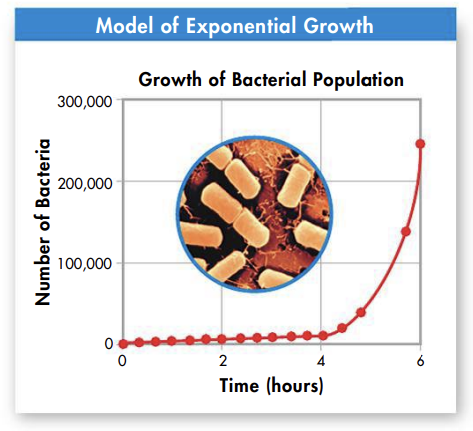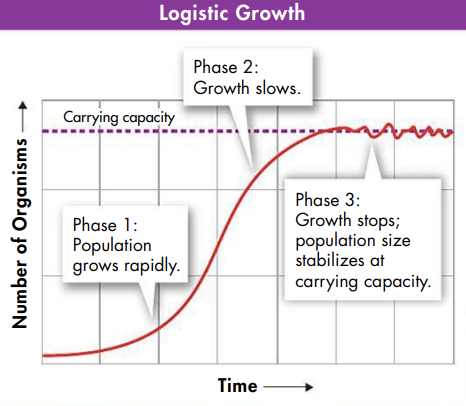
Chapter 5: Populations
5.1 How Populations Grow
Describing Populations
Ecologists study a population’s range, density, growth rate, and age structure
A population’s geographic range describes the spaces where it lives; different populations can have very different ranges
Population density is the number of individuals of a species per unit area
Population distribution describes how the organisms are spread across their range; the distribution of a population may be random, uniform, or clumped
A population’s growth rate tells you if the population size is getting bigger, smaller, or staying the same
The age structure of a population describes the number of males and females of each age in the population
Population Growth
A population may grow if more individuals are born than die in any period of time, making the birthrate is higher than the death rate
If the death rate is higher, the population may shrink
If these rates are about the same, the population may stay the same size
When individuals move into a population’s range, the process is called immigration; alternatively, when individuals move out of the range, it is called emigration
If immigration rates are higher than emigration rates, the population will grow
Exponential Growth
Exponential growth is a growth pattern in which the individuals in a population reproduce at a constant rate
When there are plenty of resources and few predators or diseases, populations will grow exponentially
In exponential growth, the larger a population gets, the more quickly it grows
When you graph the growth, the graph is in the shape of a “J”

Exponential growth occurs in nature when a species is moved into a new habitat
Logistic Growth
In the second phase of growth, population growth slows down as resources become limited
When a population’s growth slows down and stops, it is called logistic growth
A logistic growth curve is shaped like an “S”

In the third phase of growth, the growth rate drops to zero and the population size stabilizes at carrying capacity (the largest number of individuals that an area can support)
5.2 Limits to Growth
Limiting Factors
A limiting factor is any factor that controls the size of a population
Limiting factors include competition for resources, predation, parasitism and disease, unusual weather, and natural disasters
A density-dependent limiting factor is a limiting factor that depends on population density
The relationship between predators and prey is an important density-dependent factor
Ex: when people kill too many cod fish, the cod population falls; if people killed fewer cod, the population could rise again
Competition depends on population density
Predators, herbivores, parasites, diseases, and stress can affect crowded populations more
A density-independent limiting factor is a limiting factor that affects all populations in similar ways, regardless of population size
Unusual weather and natural disasters can act as density-independent limiting factors
5.3 Human Population Growth
Historical Overview
Prior to the Industrial Revolution in the 1800s, the population grew slowly; as technological advances lowered death rates, the global population began to increase much more quickly
Because of these improvements, death rates dropped, but the birthrate stayed very high, resulting in exponential growth of the human population
Patterns of Human Population Growth
The world population growth rate has slowed a lot recently
Birth rates, death rates, and age structure differ among countries and cause some countries to have high growth rates and others to have low growth rates
The scientific study of human populations is called demography
Demography looks at characteristics of human populations and tries to explain how those populations will change over time
In the demographic transition, a population changes from having high birth rates and death rates to having low birth rates and death rates
In Stage 1 of the demographic transition, birth rates and death rates are equally high
In Stage 2 of the demographic transition, the death rate begins to fall thanks to advances in nutrition, sanitation, and medicine, but birth rates remain high for a time
In Stage 3 of the demographic transition, as living standards rise, families have fewer children and the birthrate falls to meet the death rate
The demographic transition is complete when the birthrate meets the death rate
Chapter 5: Populations
5.1 How Populations Grow
Describing Populations
Ecologists study a population’s range, density, growth rate, and age structure
A population’s geographic range describes the spaces where it lives; different populations can have very different ranges
Population density is the number of individuals of a species per unit area
Population distribution describes how the organisms are spread across their range; the distribution of a population may be random, uniform, or clumped
A population’s growth rate tells you if the population size is getting bigger, smaller, or staying the same
The age structure of a population describes the number of males and females of each age in the population
Population Growth
A population may grow if more individuals are born than die in any period of time, making the birthrate is higher than the death rate
If the death rate is higher, the population may shrink
If these rates are about the same, the population may stay the same size
When individuals move into a population’s range, the process is called immigration; alternatively, when individuals move out of the range, it is called emigration
If immigration rates are higher than emigration rates, the population will grow
Exponential Growth
Exponential growth is a growth pattern in which the individuals in a population reproduce at a constant rate
When there are plenty of resources and few predators or diseases, populations will grow exponentially
In exponential growth, the larger a population gets, the more quickly it grows
When you graph the growth, the graph is in the shape of a “J”

Exponential growth occurs in nature when a species is moved into a new habitat
Logistic Growth
In the second phase of growth, population growth slows down as resources become limited
When a population’s growth slows down and stops, it is called logistic growth
A logistic growth curve is shaped like an “S”

In the third phase of growth, the growth rate drops to zero and the population size stabilizes at carrying capacity (the largest number of individuals that an area can support)
5.2 Limits to Growth
Limiting Factors
A limiting factor is any factor that controls the size of a population
Limiting factors include competition for resources, predation, parasitism and disease, unusual weather, and natural disasters
A density-dependent limiting factor is a limiting factor that depends on population density
The relationship between predators and prey is an important density-dependent factor
Ex: when people kill too many cod fish, the cod population falls; if people killed fewer cod, the population could rise again
Competition depends on population density
Predators, herbivores, parasites, diseases, and stress can affect crowded populations more
A density-independent limiting factor is a limiting factor that affects all populations in similar ways, regardless of population size
Unusual weather and natural disasters can act as density-independent limiting factors
5.3 Human Population Growth
Historical Overview
Prior to the Industrial Revolution in the 1800s, the population grew slowly; as technological advances lowered death rates, the global population began to increase much more quickly
Because of these improvements, death rates dropped, but the birthrate stayed very high, resulting in exponential growth of the human population
Patterns of Human Population Growth
The world population growth rate has slowed a lot recently
Birth rates, death rates, and age structure differ among countries and cause some countries to have high growth rates and others to have low growth rates
The scientific study of human populations is called demography
Demography looks at characteristics of human populations and tries to explain how those populations will change over time
In the demographic transition, a population changes from having high birth rates and death rates to having low birth rates and death rates
In Stage 1 of the demographic transition, birth rates and death rates are equally high
In Stage 2 of the demographic transition, the death rate begins to fall thanks to advances in nutrition, sanitation, and medicine, but birth rates remain high for a time
In Stage 3 of the demographic transition, as living standards rise, families have fewer children and the birthrate falls to meet the death rate
The demographic transition is complete when the birthrate meets the death rate
 Knowt
Knowt